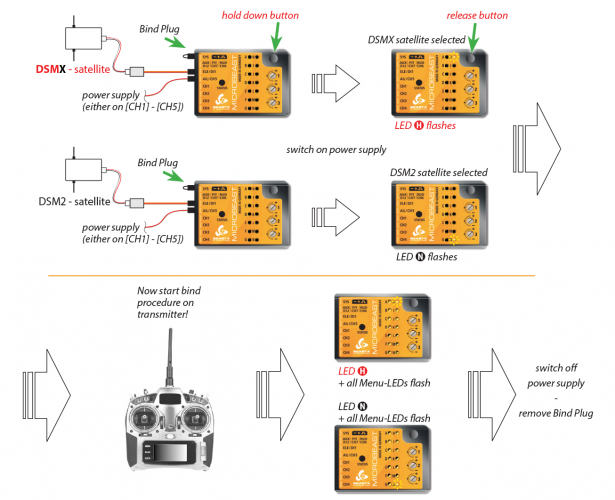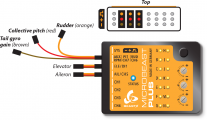Manuals:MB Plus:Receiver Installation/de: Difference between revisions
Shornstein (talk | contribs) Created page with "Grundsätzlich wird das Kabel für die Übertragung des Singlelinesignals beim MICROBEAST PLUS an den Anschluss [ELE/DI1] angesteckt. Wenn Sie das Signal eines einzelnen Spekt..." |
Updating to match new version of source page |
||
| Line 3: | Line 3: | ||
Zur Ansteuerung des MICROBEAST PLUS haben Sie die Möglichkeit ganz unterschiedliche Empfängertypen zu verwenden. Grundsätzlich wird zwischen (herkömmlichen) „Standard“ Empfängern und „Singleline“ (oder „Summensignal“) Empfängern unterschieden, bei denen die Steuersignale über nur eine einzige Anschlussleitung vom Empfänger zum Microbeast übertragen werden. | Zur Ansteuerung des MICROBEAST PLUS haben Sie die Möglichkeit ganz unterschiedliche Empfängertypen zu verwenden. Grundsätzlich wird zwischen (herkömmlichen) „Standard“ Empfängern und „Singleline“ (oder „Summensignal“) Empfängern unterschieden, bei denen die Steuersignale über nur eine einzige Anschlussleitung vom Empfänger zum Microbeast übertragen werden. | ||
=== | ===Standard receivers=== | ||
A standard receiver is a receiver that is connected to MICROBEAST PLUS by using the single servo outputs of the receiver and connect them to the five control channels of MICROBEAST PLUS. The channel which determines the controlled function simply is selected by inserting each plug to the correct output at the receiver.<br /> | |||
<br /> | |||
<gallery widths=300px> | |||
Image:Standard_RX.png | |||
Image:Spektrum_RX.png | |||
Image:Futaba_RX.png | |||
</gallery> | |||
The designation Spektrum®/Futaba® is only exemplary. You can use any radio system with at least 6 output channels to connect to MICROBEAST PLUS. For finding out how to connect the wires to MICROBEAST PLUS have a look at your radio's servo monitor and refer to the radio's instruction manual.<br /> | |||
<br /> | |||
{{QUOTE|[[Image:Warning.png|18px|sub]] Ensure a tight fit of the connectors. The pin board of MICROBEAST PLUS is designed so that the plugs firmly clamp each other when they are fully inserted. Anyhow, especially when using a single-line receiver, it is possible that connectors are plugged in with no adjacent neighbors. Such plugs should additionally be secured against loosening.}}<br /> | |||
<br /> | |||
===Singlelineempfänger=== | ===Singlelineempfänger=== | ||
| Line 12: | Line 22: | ||
Grundsätzlich wird das Kabel für die Übertragung des Singlelinesignals beim MICROBEAST PLUS an den Anschluss [ELE/DI1] angesteckt. Wenn Sie das Signal eines einzelnen Spektrum Satellitenempfängers empfangen wollen, beachten Sie, dass hier unbedingt der separat erhältliche Spektrum Satellitenadapter (Best.Nr. BXA76009) zwischengesteckt werden muss, der die Ausgangsspannung auf ein notwendiges Mass reduziert. | Grundsätzlich wird das Kabel für die Übertragung des Singlelinesignals beim MICROBEAST PLUS an den Anschluss [ELE/DI1] angesteckt. Wenn Sie das Signal eines einzelnen Spektrum Satellitenempfängers empfangen wollen, beachten Sie, dass hier unbedingt der separat erhältliche Spektrum Satellitenadapter (Best.Nr. BXA76009) zwischengesteckt werden muss, der die Ausgangsspannung auf ein notwendiges Mass reduziert. | ||
===Receiver binding=== | |||
Before using your receiver with MICROBEAST PLUS make sure that the receiver is bound to the transmitter and that it is sending output data on the servo outputs and/or single-line port. Please refer to the manual of your radio system to find out how binding procedure is performed with your specific system. Also check if there is the need to perform special settings to enable the single-line data output of the receiver in case you intend to use this output port in combination with MICROBEAST PLUS.<br /> | |||
<br /> | |||
Only in the case of using a single Spektrum® satellite receiver that is directly connected to MICROBEAST PLUS, this is bound by the aid of MICROBEAST PLUS as there is no other option to enable binding procedure at the receiver. Even more, here it is very important to bind the receiver first before programming MICROBEAST PLUS and this step must be performed, even if the satellite was already in use elsewhere (e. g. in connection with a “Standard” Spektrum® receiver) and was already bound to the transmitter earlier.<br > | |||
<br > | |||
{{WARNING_QUOTE|'''Watch out that the motor can not start accidentally when using the BEC of your speed controller to power the unit!'''<br /> | |||
<br /> | |||
'''Simultaneously with the binding process, the type of satellite receiver has to be set, i.e. whether it is a DSMX or DSM2 satellite (The actual selected signal protocol in the transmitter is not relevant!). It is very important to choose the correct type of satellite receiver here, since an improper setting may seem to work but can lead to radio interference or total loss of the link in the subsequent operation!'''<br /> | |||
<br /> | |||
Insert a Spektrum® “Bind Plug” at the [SYS] port of MICROBEAST PLUS. In case the power is supplied exclusively at the [SYS] connection, to bind a Spektrum® satellite receiver the power supply must be provided temporarily through any of the other ports [CH1] - [CH5].<br /> | |||
<br /> | |||
To select a DSM2 satellite and to enter bind mode, simply switch on the power supply now. The LED on the receiver and LED '''N''' on MICROBEAST PLUS will start to flash. You can bind the transmitter as usual (for more information refer to the instructions of your radio control system).<br /> | |||
<br /> | |||
To select and bind a DSMX satellite, hold down the button on MICROBEAST PLUS while switching on the power supply. Now the receiver‘s LED and LED '''H''' (!) on the MICROBEAST PLUS will flash and you can release the button and bind the receiver with your transmitter.<br /> | |||
<br /> | |||
After successful binding procedure the receiver‘s LED will stay solid. LED '''H''' respectively '''N''' flash alternately to all other LEDs. Now switch off the power supply and remove the bind plug. Continue with receiver type setup (see next chapter).<br /> | |||
<br /> | |||
It makes no difference if you pull off the “Bind Plug” during the binding process or leave it connected as you would expect from some “standard” Spektrum® receivers.}}<br /> | |||
<br /> | |||
[[File:Spektrum_bind.png|x500px|border]]<br /> | |||
<br /> | |||
Decisive for the selection alone is, which type of satellite receiver is plugged in! It is irrelevant which transmission method between the receiver and transmitter is actually used. Check carefully what type of receiver you have and what type you setup. An incorrect setting is not obvious but will lead to malfunction or failure of the radio link later in use. | |||
Revision as of 09:05, 19 May 2015
Zur Ansteuerung des MICROBEAST PLUS haben Sie die Möglichkeit ganz unterschiedliche Empfängertypen zu verwenden. Grundsätzlich wird zwischen (herkömmlichen) „Standard“ Empfängern und „Singleline“ (oder „Summensignal“) Empfängern unterschieden, bei denen die Steuersignale über nur eine einzige Anschlussleitung vom Empfänger zum Microbeast übertragen werden.
Standard receivers
A standard receiver is a receiver that is connected to MICROBEAST PLUS by using the single servo outputs of the receiver and connect them to the five control channels of MICROBEAST PLUS. The channel which determines the controlled function simply is selected by inserting each plug to the correct output at the receiver.
The designation Spektrum®/Futaba® is only exemplary. You can use any radio system with at least 6 output channels to connect to MICROBEAST PLUS. For finding out how to connect the wires to MICROBEAST PLUS have a look at your radio's servo monitor and refer to the radio's instruction manual.
Ensure a tight fit of the connectors. The pin board of MICROBEAST PLUS is designed so that the plugs firmly clamp each other when they are fully inserted. Anyhow, especially when using a single-line receiver, it is possible that connectors are plugged in with no adjacent neighbors. Such plugs should additionally be secured against loosening.
Singlelineempfänger
Bei einem Singleline Empfänger werden alle Steuerbefehle (Fernsteuerkanäle) gemeinsam über nur einen einzigen Anschluss zum MICROBEAST PLUS übertragen. Die Kanalinformationen sind hierbei in vielen Fällen digital kodiert, so dass herstellerspezifische Unterschiede bestehen. Darüber hinaus ist es hier nicht möglich, durch passendes Einstecken die Zuordnung von Kanal zu Steuerfunktion festzulegen. Stattdessen wird die Kanalzuordnung per Software im Empfängereinstellmenü des MICROBEAST PLUS vorgegeben.
Singleline Empfänger können zusätzlich auch Einzelanschlüsse haben, so wie ein Standard Empfänger. In Verbindung mit dem MICROBEAST PLUS müssen Sie ihn nur dann als Singleline Empfänger behandeln, wenn Sie ihn auch als solchen anschließen, also die Ansteuerung der Funktionen des MICROBEAST PLUS über nur eine einzelne Leitung geschieht. Anderenfalls ist der Empfänger als "Standard" Empfänger zu behandeln!
Grundsätzlich wird das Kabel für die Übertragung des Singlelinesignals beim MICROBEAST PLUS an den Anschluss [ELE/DI1] angesteckt. Wenn Sie das Signal eines einzelnen Spektrum Satellitenempfängers empfangen wollen, beachten Sie, dass hier unbedingt der separat erhältliche Spektrum Satellitenadapter (Best.Nr. BXA76009) zwischengesteckt werden muss, der die Ausgangsspannung auf ein notwendiges Mass reduziert.
Receiver binding
Before using your receiver with MICROBEAST PLUS make sure that the receiver is bound to the transmitter and that it is sending output data on the servo outputs and/or single-line port. Please refer to the manual of your radio system to find out how binding procedure is performed with your specific system. Also check if there is the need to perform special settings to enable the single-line data output of the receiver in case you intend to use this output port in combination with MICROBEAST PLUS.
Only in the case of using a single Spektrum® satellite receiver that is directly connected to MICROBEAST PLUS, this is bound by the aid of MICROBEAST PLUS as there is no other option to enable binding procedure at the receiver. Even more, here it is very important to bind the receiver first before programming MICROBEAST PLUS and this step must be performed, even if the satellite was already in use elsewhere (e. g. in connection with a “Standard” Spektrum® receiver) and was already bound to the transmitter earlier.
Watch out that the motor can not start accidentally when using the BEC of your speed controller to power the unit!
Simultaneously with the binding process, the type of satellite receiver has to be set, i.e. whether it is a DSMX or DSM2 satellite (The actual selected signal protocol in the transmitter is not relevant!). It is very important to choose the correct type of satellite receiver here, since an improper setting may seem to work but can lead to radio interference or total loss of the link in the subsequent operation!
Insert a Spektrum® “Bind Plug” at the [SYS] port of MICROBEAST PLUS. In case the power is supplied exclusively at the [SYS] connection, to bind a Spektrum® satellite receiver the power supply must be provided temporarily through any of the other ports [CH1] - [CH5].
To select a DSM2 satellite and to enter bind mode, simply switch on the power supply now. The LED on the receiver and LED N on MICROBEAST PLUS will start to flash. You can bind the transmitter as usual (for more information refer to the instructions of your radio control system).
To select and bind a DSMX satellite, hold down the button on MICROBEAST PLUS while switching on the power supply. Now the receiver‘s LED and LED H (!) on the MICROBEAST PLUS will flash and you can release the button and bind the receiver with your transmitter.
After successful binding procedure the receiver‘s LED will stay solid. LED H respectively N flash alternately to all other LEDs. Now switch off the power supply and remove the bind plug. Continue with receiver type setup (see next chapter).
It makes no difference if you pull off the “Bind Plug” during the binding process or leave it connected as you would expect from some “standard” Spektrum® receivers.

Decisive for the selection alone is, which type of satellite receiver is plugged in! It is irrelevant which transmission method between the receiver and transmitter is actually used. Check carefully what type of receiver you have and what type you setup. An incorrect setting is not obvious but will lead to malfunction or failure of the radio link later in use.


